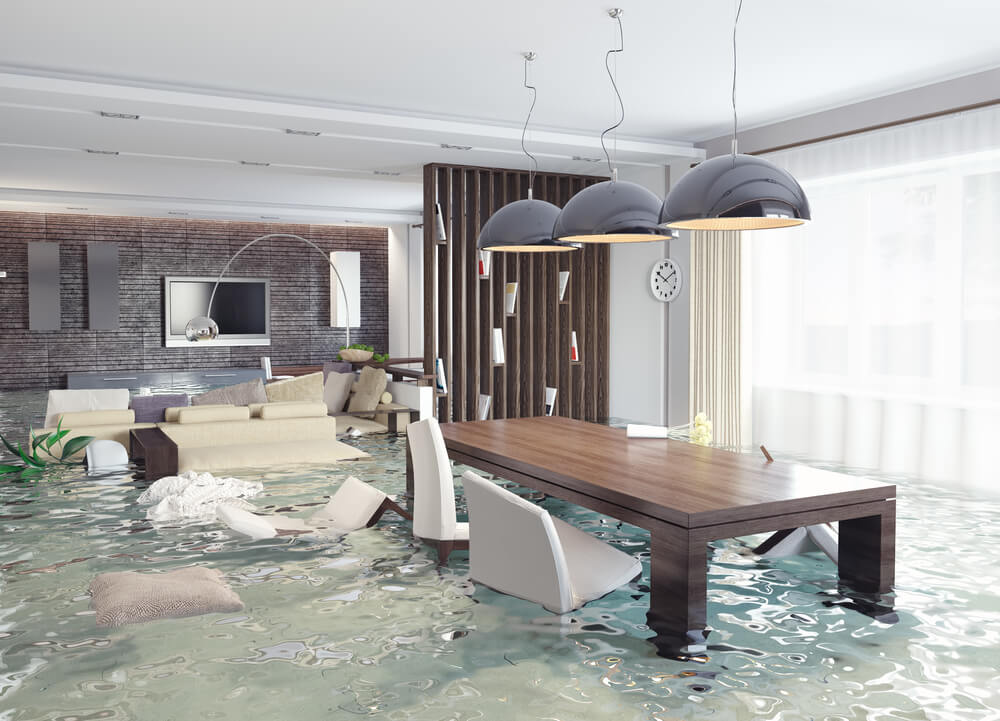Despite what many homeowners may think, floods can happen to anyone, anywhere, at any time. According to recent data from the NFIP, the average rate of flood insurance claims is steadily rising. Surprisingly, about 25% of all flood claims come from areas not considered high-risk. That being said, it’s vital to safeguard your property from treacherous floodwaters—and we’ll tell you how to get your home dry and cozy again.
How Does a Flood Impact Your Home or Business?
Whether it be from heavy rain or severe plumbing malfunctions, water can wreak havoc on your property. It finds its way into your home through cracks in the foundation or walls, the roof, or even broken windows.
Once inside, water can damage anything from furniture, hardwood floors and panels, and appliances to the structural integrity of your home. Mold goes hand-in-hand with flood disasters, which can lead to respiratory illnesses and diseases.
5 Most Common Hazards Associated With Flood Damage
1. Water Damage
Water can destroy valuable personal items such as clothes, furniture, appliances, and other possessions. It fosters the growth of mold spores and mildew, which can pose serious health risks.
2. Electrical Hazards
Water and electricity don’t mix well. If you notice wires or electrical outlets underwater, turn the power off immediately and call a professional for emergency assistance.
3. Fire Hazards
Wet areas provide an ideal setting for fires to ignite. A little heat and a spark can set your home in flames while you’re busy dealing with other flood damage problems.
4. Structural Failure
Floodwaters can soften your home’s foundation, jeopardizing its structure. If the weight becomes too much for the ground to support, the house could collapse.
5. Carbon Monoxide
Flood damage can lead to sewage contamination and carbon monoxide exposure, which can cause severe—and potentially fatal—health risks.
What Health Risks Result From Floods?
While mold and mildew can threaten your household with hazardous illnesses, there are other potential health issues lurking within those floodwaters. Floodwaters can contain various microorganisms that cause diseases and infections when they enter homes. Here are a few examples:
Leptospirosis
This bacterial disease exhibits high fever, severe headache, chills, vomiting, jaundice, red eyes, and abdominal pain. It’s found in black water.
Giardiasis
Giardiasis is a diarrheal illness caused by a parasite found in contaminated water. Its symptoms include diarrhea, gas, stomach cramps, and dehydration.
Cryptosporidiosis
This diarrheal illness is caused by a tiny organism that can survive outside the body for extended periods. Symptoms include watery diarrhea, stomach cramps, bloating, nausea, and weight loss.
The Dangers of Electrical and Gas During a Flood
When water and electricity mix, it can have fatal consequences. Always consider electrically damaged parts of your home as potentially hazardous during a flood. If you observe wires or outlets submerged in water, do not attempt any repairs without first turning off the power from a safe location.
Gas lines can also be damaged during a flood. If you detect a gas smell in your home after a flood, evacuate immediately and call your gas company from a neighbor’s phone.
How Can I Determine if My Home Has Suffered Flood Damage?
If you suspect that your home is damaged from a flood, it’s important to contact Same Day Restoration. We have the tools and know-how needed to assess your property and devise the best possible action plan to mitigate and restore it.

What Should I Do if My Home Is Flooded?
If your home is flooded, here are a few important steps to take:
Stay Safe
Be cautious of potential hazards like electrical shocks and fire. Don’t come in contact with floodwaters, especially if you feel unsafe.
Turn Off Power
If you notice wires or outlets underwater, turn the power off immediately. Otherwise, an electrical disaster can spark.
Remove Wet Items
Remove all wet items and valuables from your home to minimize damage.
Contact Same Day Restoration
Get emergency help by contacting Same Day Restoration. We work around the clock to meet your needs when you need us most.
File an Insurance Claim
Contact your insurance company promptly to initiate the claims process and seek assistance for damages.
What Is the Process for Filing a Flood Insurance Claim?
The process for filing a flood insurance claim varies depending on your insurance company. Remember to take photos of the damage, save receipts, and follow and maintain communication with your insurance provider throughout the process.
Get Same-Day Flood Damage Restoration, 24/7
Since 2007, Same Day Restoration has helped hundreds of homeowners and business owners across Southern California. Our team is well-versed in water damage, fire damage, mold removal, and much more. Contact the restoration team you can trust to get 24-hour emergency flood cleanup and restoration services.
